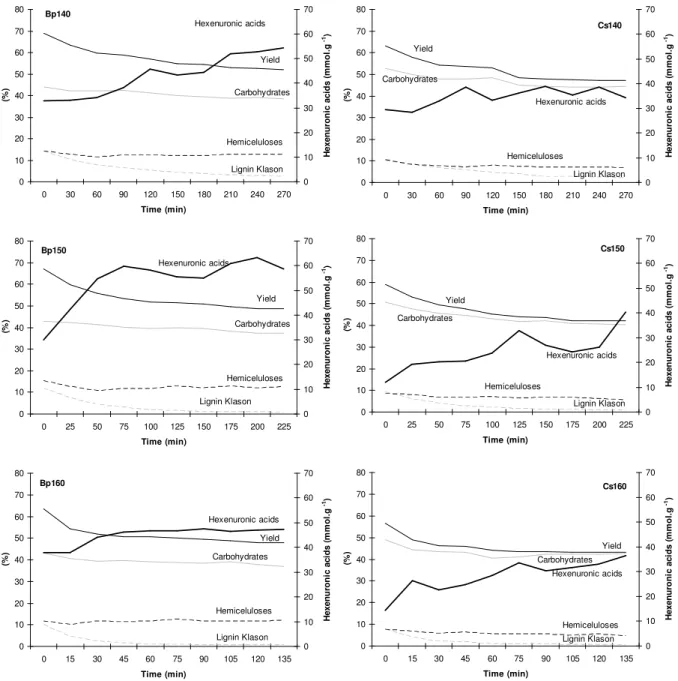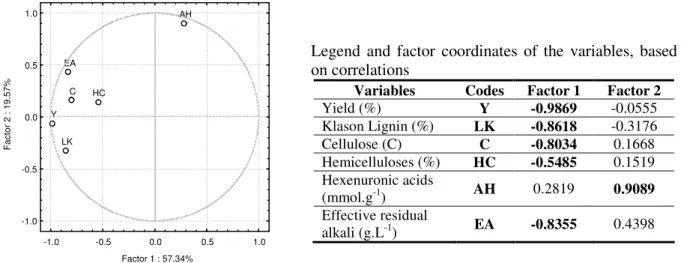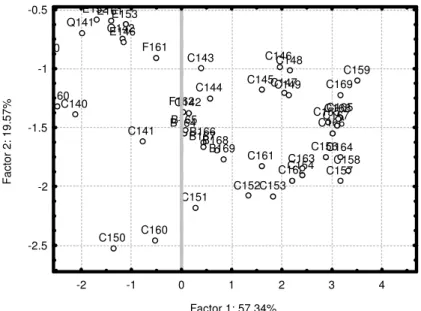XXI TECNICELPA Conference and Exhibition / VI CIADICYP 2010 12-15 October 2010, Lisbon, Portugal
EVALUATION OF KRAF COOKING BEHAVIOUR FOR DIFERENT HARDWOOD SPECIES
Marta Margarido1,2*, Ofélia Anjos2,3, Denilson Da Silva Perez 4, Gérard Mortha1 1
PAGORA Grenoble INP, Laboratory of Wood and Pulping Chemistry and Processes (LGP2) UMR-CNRS 5518, Domaine Universitaire, F-38400 Saint Martin d’Hères, France
2
Cernas - CERNAS – Research centre of natural resources, environmental and society. Bencata, 3040-316 Coimbra, Portugal
3
Polytechnic Institute of Castelo Branco (Agrarian School), Quinta da Senhora de Mércules, Apartado 119 – 6001 Castelo Branco – Portugal.
4
FCBA, Domaine Universitaire, Grenoble, France.
SUMMARY
In this study six wood species (birch, chestnut, oak, beech, poplar and eucalyptus) were analysed separately. Lignin content, Polysaccharides content (cellulose and hemicelluloses), Yield, Hexenuronic acids were evaluated for three cooking temperatures (140ºC, 150ºC and 160ºC) and different cooking times. Common cooking conditions were applied and temperature program included cold impregnation, a plateau at 110°C (2.5 hours) to perform initial delignification separately followed by a second plateau at cooking temperature.
The results of PCA show that the almost all parameters (excluding hexenuronic acids) are well correlated between them (total variance: 62%). For Eucalyptus and poplar species the hemicelluloses content aren’t well correlated with the previously parameter, caused by the difference observed for the higher temperatures. In some samples was observed that xylans are partially resistant and their elimination is only partial (30 to 40%) in the early stage of cooking.
For the highest cooking time there were observed a significant difference between the three temperatures studied.
Chestnut and oak wood species present a different behaviour compared with the other species, caused by their similar anatomical and chemical structure. For the 160º of cooking temperature in the second plateau was the poplar, beech and birch that present a different performance.
Keywords: Kraft cooking, hardwoods, lignin content, polysaccharides content, Hexenuronic acids.
INTRODUCTION
Wood is one of the most important materials of the pulp and paper industry. The quality of wood supplied to the process and pulp obtained is often correlated, and the wood cost is the determinant factor for the profitability of a mill.
Kraft pulping kinetics has been extensively studied and described since the late 50’s. A number of studies concerning different wood species can be found in the literature [1-11]. Since then, experimental methods and interpretation methods have changed and it appears sometimes difficult to compare the behaviour of different wood species, especially if studies were produced in different periods and/or issued from different authors.
Various wood species used for Kraft pulp production are significantly different by their morphological and chemical properties. Although the chemical kinetics and its variability among species is probably the most important factor that affects cooking characteristics, in a general way it would be economically benefit if the pulp at the end of the cooking sequence presents a lower quantity of lignin content and higher percentage of hemicelluloses.
EXPERIMENTAL
Wood species
Samples wood chips were cut as thin half-disks (~1.8 mm thickness). The wood species used in this study are represented in Table 1.
Table 1. Hardwood species submitted to kraft cooking, scientific name and symbol adopt in the work.
Wood Scientific name Abbreviation
Birch Betula pubescens Bp
Chestnut Castanea sativa Cs
Oak Quercus spp. Qu
Beech Fagus sylvatica Fs
Poplar Populus spp. Po
Eucalyptus Eucalyptus globulus Eg
Cooking conditions
11 g of chips (o.d. basis) and 65 mL of white liquor were introduced in mini-digesters (85 mL). Heating-up program allowed to perform initial delignification first (30 min to 110°C, 2.5 h), then bulk delignification: rapid heat-up to cooking temperature at 140°C (14 min), 150°C (18 min), 160°C (21 min), 170°C (25 min), and plateau time. Cooking conditions were EA=25% NaOH/wood, S= 34%, L/W=6.
Figure 1. Example of a non-uniform cooking sequence (160ºC).
The pulp yields, residual effective alkali, Klason lignin (wood and pulp), polysaccharides content (wood and pulp) and hexenuronic acids content were determined according to the standard methods
0 20 40 60 80 100 120 140 160 180 0 5000 10000 15000 20000 0 1 2 3 4 5 6 7 8 9 10 11 Cooking time (s) T em p era tu re (° C ) 0 20 40 60 80 100 120 140 160 180 0 5000 10000 15000 20000 0 1 2 3 4 5 6 7 8 9 10 11 0 20 40 60 80 100 120 140 160 180 0 5000 10000 15000 20000 0 1 2 3 4 5 6 7 8 9 10 11 Cooking time (s) T em p era tu re (° C )
RESULTS AND DISCUSSION
Figure 2 shows an example of the behaviour for two wood species studied, in this case, we only present birch and chestnut, because represent two species with different characteristics. In this Figure it is possible to observe pulp yield, Klason lignin content, carbohydrates content, hemicelluloses content and Hexenuronic acids content, in function of removal time from the second plateau.
Figure 2. Variation of different parameters measured during the kraft cooking (Yield, Klason lignin, Carbohydrates, Hemicelluloses and Hexenuronic acids) in function of time, for the three temperatures
(140ºC, 150ºC and 160ºC) studied.
Left graphics of Figure 2, corresponding to birch species, shows that the loss of yield and lignin is rather linear between them, meaning, the loss of lignin contributes essentially for the lost of the yield during the cooking sequence. In the case of carbohydrates (including hemicelluloses) it is possible to observe that during the cooking plateau is rather constant. Hexenuronic acids present an increase during the cooking sequence, independent on the temperature.
For the chestnut wood, at the beginning of cooking temperature, independent of the temperature
0 10 20 30 40 50 60 70 80 0 30 60 90 120 150 180 210 240 270 Time (min) (% ) 0 10 20 30 40 50 60 70 H e x e n u ro n ic a c id s ( m m o l. g -1) Yield Lignin Klason Carbohydrates Hemiceluloses Hexenuronic acids Bp140 0 10 20 30 40 50 60 70 80 0 25 50 75 100 125 150 175 200 225 Time (min) (% ) 0 10 20 30 40 50 60 70 H e x e n u ro n ic a c id s ( m m o l. g -1) Yield Lignin Klason Carbohydrates Hemiceluloses Hexenuronic acids Bp150 0 10 20 30 40 50 60 70 80 0 15 30 45 60 75 90 105 120 135 Time (min) (% ) 0 10 20 30 40 50 60 70 H e x e n u ro n ic a c id s ( m m o l. g -1) Yield Lignin Klason Carbohydrates Hemiceluloses Hexenuronic acids Bp160 0 10 20 30 40 50 60 70 80 0 30 60 90 120 150 180 210 240 270 Time (min) (% ) 0 10 20 30 40 50 60 70 H e x e n u ro n ic a c id s ( m m o l. g -1) Yield Lignin Klason Carbohydrates Hemiceluloses Hexenuronic acids Cs140 0 10 20 30 40 50 60 70 80 0 25 50 75 100 125 150 175 200 225 Time (min) (% ) 0 10 20 30 40 50 60 70 H e x e n u ro n ic a c id s ( m m o l. g -1) Yield Lignin Klason Carbohydrates Hemiceluloses Hexenuronic acids Cs150 0 10 20 30 40 50 60 70 80 0 15 30 45 60 75 90 105 120 135 Time (min) (% ) 0 10 20 30 40 50 60 70 H e x e n u ro n ic a c id s ( m m o l. g -1) Yield Lignin Klason Carbohydrates Hemiceluloses Hexenuronic acids Cs160
studied, the quantities obtained were lower that in the case of birch wood. That behaviour could be explained by the very high percentage of extractives in the chestnut wood (16%), so when reach the cooking temperature, a bigger quantity of material was already removed, also because the consumption of the residual effective alkali is higher that for the other wood species, leading to the lower quantity obtained in lignin.
In a general way, the chestnut and oak wood behaviour during the kraft cooking is different concerning the other species studied.
After the comparisons between all the hardwoods species analysed, for all the temperatures, the yield presented a similar behaviour having a variation of 6,6%, knowing that, the lower value correspond to oak, were the extractives content represent 13% in the wood. In a general way, the lignin content is around 2 % and the carbohydrates content correspond to 45-50 %. Concerning the hexenuronic acids, an increase is observed, independent on the temperature studied. For all the temperatures it is shown that chestnut produce less quantity of hexenuronic acids, showing a very large difference relating to the others species.
Statistical analysis
Principal components analysis was used to investigate the correlations between yield ad the other parameters studies and the different times and temperatures level.
For the correlation between the factor evaluated two factors were chosen in this study because explains 69% of total variation. Figure 3 represents the projection of variables on the factor-plane. The first component, which represents the Yield variation, explains 62.11 % and the second, who represent the hexenuronic acids, explains 17.27 % of total variation.
Factor 1, which defines the first component of cooking performance, includes a series of properties, which are significantly correlated amongst themselves: Yield (Y), Klason lignin (LK), carbohydrates (TC), cellulose content (C), and effective residual alkali (EA). The hexenuronic acids (HA) was explained by the Factor 2 and wasn’t well correlated with the previously parameters.
Legend and factor coordinates of the variables, based on correlations
Variables Codes Factor 1 Factor 2
Yield (%) Y -0.9869 -0.0555 Klason Lignin (%) LK -0.8618 -0.3176 Cellulose (C) C -0.8034 0.1668 Hemicelluloses (%) HC -0.5485 0.1519 Hexenuronic acids (mmol.g-1) AH 0.2819 0.9089 Effective residual alkali (g.L-1) EA -0.8355 0.4398
Figure 3. Relative distribution of kraft cooking properties of different hardwood species according to the factors resulting from Principal components analysis.
It was also projected cases into the same system of vectors to know the correlation between different wood species and different temperature cooking condition. For the species studied there are difference related to wood anatomy and chemical composition. Castanea sativa and Quercus spp. have ring porosity and the other species present diffuse porosity. Quercus spp. has a great amount of parênquima
Y LK C HC AH EA -1.0 -0.5 0.0 0.5 1.0 Factor 1 : 57.34% -1.0 -0.5 0.0 0.5 1.0 F a c to r 2 : 1 9 .5 7 %
and very large rays. In addition, Castanea sativa and Quercus spp. present higher extractives content, lower cellulose and hemicellulose content. Those characteristics influence kraft cooking performance. When it was represented the cases in the some system of vector resulting from the PCA analysis we find that the Castanea sativa present a very different behaviour from the other species (Figure 4). That difference can be explained by the anatomical and chemical differences reported previously. Quercus
spp. present a behaviour different from the Castanea sativa because have a lower extractive content and higher cellulose content when compared with that specie. In Figure 4 were represented only a part of the diagram corresponding to the PCA analysis because the number of sample difficult the interpretation of complete representation.
B164B165 B166 B167B168 B169 C140 C141 C142 C143 C144 C145 C146 C147 C148 C149 C150 C151 C152C153 C154 C155 C156 C157C158 C159 C160 C161 C162 C163 C164 C165 C166C167 C168 C169 Q141 Q142 Q160 E146 E152 E153E161
F160 F161 F162 P160 -2 -1 0 1 2 3 4 Factor 1: 57.34% -2.5 -2 -1.5 -1 -0.5 F a c to r 2 : 1 9 .5 7 %
Figure 4. Projection of the wood samples from different temperatures and removing samples times, on the plane of the two main factors resulting form principal component analysis. The first letter represents the
wood species (C – Castanea sativa; Q – Quercus spp.; F – Fagus sylvatica), the second two numbers represents the cooking temperature (14- 140ºC;15-150ºC;16-160ºC) and the third number represent the
time on second plateau were was removed the sample to analysed.
For the other species the separation between them was not so evident but it is possible find a trend of separation by the different cooking times and temperatures at the 2º plateau. An example of that behaviour was showed for the B. pubescens on Figure 5.
B140 B141 B142 B143 B144 B145B146 B147B148B149 B150 B151 B152 B153B154 B155B156 B157B158 B159 B160 B161 B162B163 B164 B165B166B167B168B169 -4 -2 0 2 Factor 1: 68.12% -1.5 -1.0 -0.5 0.0 0.5 1.0 1.5 F a c to r 2 : 1 6 .7 7 %
Figure 5. Projection of the B. pubescens (B) from different temperatures and removing samples times, on the plane of the two main factors resulting form principal component analysis.
The separation of C. sativa specie behaviour was clear wen used the ANOVA results (Tabela 2). In fact for all measured parameters the observed values present statistical difference (Tukey's test, P<0.05) from the other species. The behaviour could be explained by the difference in the anatomical structure and chemical composition explained previously.
Table 2. Statistical differences, made by ANOVA using the Tukey HSD test, presented for the wood species in several parameters studied.
Yield (%) Lignin (%) Cellulose (%) Hemicelluloses
(%)
Hexenuronic acids
(µµµmol/g) µ
Residual effective alkali (g/L)
Cs(a) Qu(a) Cs(a) Cs(a) Cs(a) Cs(a)
Qu(a) Fs(a) Bp(b) Qu(b) Eg(b) Qu(b)
Fs(b) Eg(a) Fs(b) Po(b) Bp(b) Fs(c)
Bp(b) Cs(a) Qu(b) Eg(c) Fs(b,c) Eg(c,d)
Po(b) Po(a) Eg(c) Fs(d) Qu(b,c) Bp(d)
Eg(b) Bp(a) Po(c) Bp(e) Po(c) Po(e)
The different temperature used for cooking sequence (140ºC, 150ºC and 160ºC) present results statistically different for the yield, residual effective alkali and hemicelluloses content. In fact when the cooking was made at a lower temperature (140ºC) the delignification was lower and consequently the yield and the residual effective alkali were lower too. The lignin content was higher in the lower temperature and statistically different from the too other temperature. The difference in the delignification for 150ºC and 160ºC were statistically similar but higher for the lower temperature. The dependence of the cellulose content and cooking temperature was predictable too with ANOVA, in fact the cellulose content increase from the lower temperature to the higher temperature and the extremes temperature are significantly different.
For the Yield, lignin content, cellulose content and residual effective alkali, it was observed a statically difference until the 5th time measured. After that valour the increasing in the parameter aren’t significant. Moreover the increase of the time cooking, influence more the hemicellulose content and was observed a significant difference until the 3nd and after that the increase aren’t statistical significant. Similar results are founded for the Hexenuronic acids.
CONCLUSIONS
The initial delignification concept was validated, however, instead of using a plateau of 110ºC, a plateau of 130ºC was carried out, it would be preferable, in this way we would be shore that the initial delignification it would be complete (1, 12, 13). Extent of initial delignification was highly varying within species and generally more important for hardwoods than for softwoods. Correlatively, highly varying alkali consumption and extractives removal during low temperature phases were observed. The behaviour of polysaccharides was studied separately. Concerning hemicelluloses, a rapid removal occurs at the beginning of the cooking sequence, than depending on the wood species, two behaviours appears: one reaching a plateau, and for others the continuation of the elimination with a constant rate is observed.
Hexenuronic acids present always an increase of the formation along the cooking sequence.
REFERENCES
1. H. J. Cho, K. V. Sarkanen, Alternatives of H-factor measurement in the kraft process, Paperi Puu, 66(3) 121-124 (1985).
2. R. R. Gustafson, C. A. Sleicher, W. T. McKean, B. A. Finlayson, Theoretical model of kraft pulping process
Ind. Eng. Chem.Process Des. Dev., 22(1) 87-96 (1983).
3. L. Olm, P. J. Nelson, S. E. Campbell, The rate of delignification of Eucalyptus diversicolor, E. regnans, E.
marginata and E. tetradonta wood during kraft pulping, Appita, 37(4) 314-318 (1984)
4. G. Mortha, K. Sarkanen, R. Gustafson, Alkaline pulping kinetic of short-rotation, intensively cultured hybrid poplar, Tappi Journal, 75(11) 99-104 (1992)
5. M. A. Gilarranz, A Santos, J. Garcia, M. Oliet, F. Rodriguez, Kraft Pulping of Eucalyptus globulus: Kinetic of residual delignification, Ind. Eng. Chem. Res., 41(8) 1955-1959 (2002).
6. R. G. Fullgraff, D. L. Melo, E. R. Canales, Experimental pulping kinetics of Pinus radiate cultivated in Chile
Tappi Journal, 6(10) 12-18 (2007).
7. G. Jiménez, R. R. Gustafson, W. T. McKean, Modelling Incomplete Penetration of Kraft pulping Liqueur
JPPS 15(3) J110-J115 (1989).
8. R. Giudici, S. W. Park, Kinetic model for kraft pulping hardwoods, Ind. Eng. Chem. Res., 35(3) 856-863 (1996).
9. M. Kubo, H. Yoshioka, M. Tamao, T. Uero, A kinetic model of delignification in kraft pulping, Japan TAPPI International Symposium on wood and Pulping Chemistry 2 130-135 (1983).
10. L. Yang, S. Liu, Kinetic model for kraft pulping process, Ind. Eng. Chem. Res., 44(18) 7078-7085 (2005). 11. S. Rekunen, E. Jutila, E. Lahteenmaki, B. Lonnberg, N.-E. Virkola, Examination of reaction kinetic in kraft
cooking, Paperi Puu, 2 80-90 (1980).
12. R. R. Gustafson, The role of diffusion during initial delignification of alkaline pulping, Tappi Journal, 51(4) 145-147 (1998).




